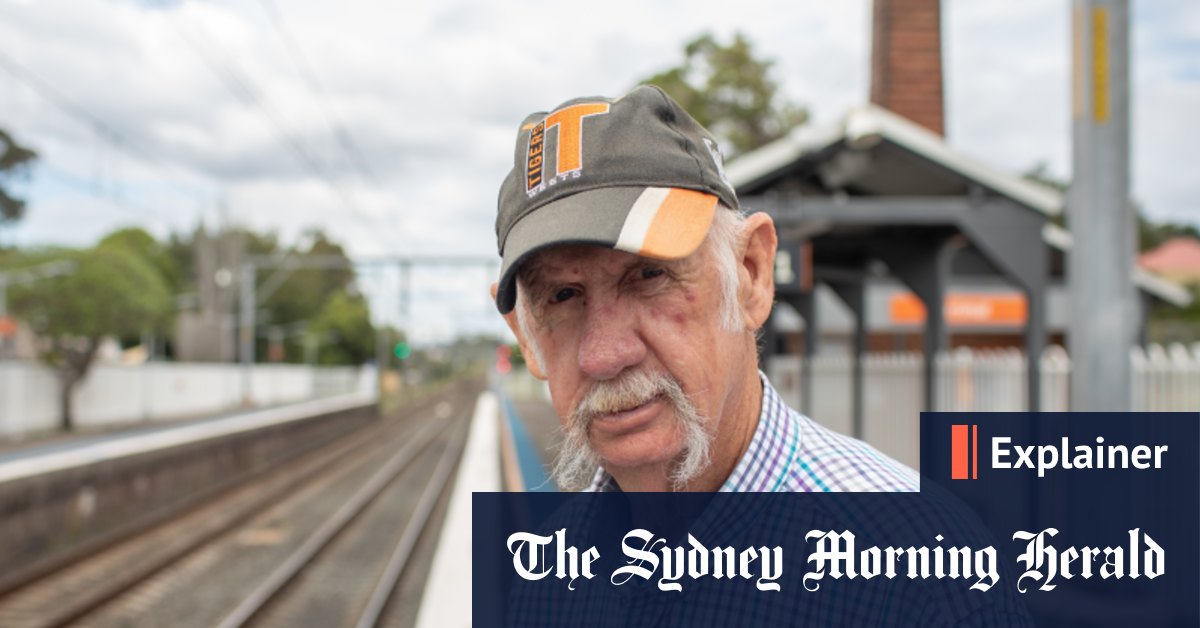Bob Petersen slept on trains for two years before the pandemic. Nearly every night, he’d ride more than 100 kilometres of rail, from Sydney to Kiama and back again. Sometimes he’d wake in Newcastle, sometimes Port Kembla, but he always paid his fare. “And I tried to keep myself neat and tidy so no one would bother me,†the 74-year-old says.
Now he has a home.
Bob Petersen was helped off the street into an affordable rental by not-for-profit Housing Trust thanks to NSW funding during COVID.Credit:Mark Newsham
In Melbourne, Glenn Kent is also excited to pay his first month’s rent. After more than 15 years sleeping rough, and a lifetime bounced around clinics, shelters, the justice system and, most recently COVID hotels, Kent, 50, has finally got the keys to his own place – a unit that costs just a quarter of his disability pension. It’s somewhere he can fix his bike, bake cakes for the local church, return to his artwork and keep “out of troubleâ€.
This is the answer to homelessness: more affordable homes. It might sound too simple. Or, as Kent first thought, too good to be true. But if the pandemic has taught us anything it’s that much of what was once considered impossible, or at least impractical, can be achieved, and quickly, if we want it enough.
As the streets of our cities emptied to stop the spread of COVID-19, tens of thousands of Australians without shelter were put up in hotels and rentals as part of a mammoth effort by state governments and frontline services. For a lucky minority, such as Petersen and Kent, the new digs have become permanent. But some are already finding themselves back where they started.
“People walk past homelessness thinking it’s one of those things that’ll never change,†says University of Queensland researcher Cameron Parsell. â€They also think it doesn’t cost them anything. They’re wrong on [both fronts].†Parsell’s work has shown leaving someone on the street long-termcosts about $13,000 more per person every year than placing them in supported housing.
Now, with the economy in need of a jobs-intensive stimulus spend and thousands more Australians expected to slide into homelessness in the COVID recession, the business case for building more of this “social housing†is stronger than ever.
“We are staring down a tsunami of homelessness,†warns Bevan Warner who heads up the not-for-profit service Launch Housing in Melbourne. “We started with a housing crisis in Australia and it became a health crisis, which became an economic crisis. Now we have an opportunity to solve all three.â€
So how much social housing do we need and what will it cost? Why was it missing in the federal government’s big-spending budget? Are COVID emergency measures helping end street homelessness? And how have other countries such as Finland done it already?
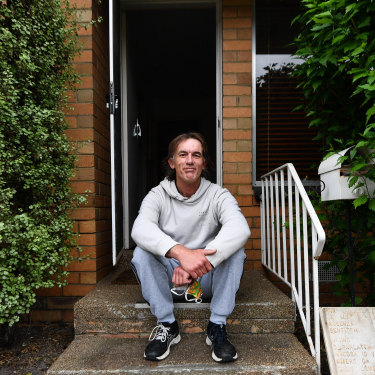
Glenn Kent is excited to pay his first bill now he is in a secure, long-term rental.Credit:Joe Armao
How is homelessness defined – and how common is it?
On the last census night in 2016, more than 116,000 Australians were recorded without secure housing, 8200 of them sleeping rough. That’s generally considered an underestimate. But in 2020, measures to house people during the pandemic have revealed even more about the scale of the problem.
The latest Homelessness Monitor – independent research by Parsell and others commissioned by Launch – estimated at least 33,000 people sleeping rough, couch-surfing or in crowded shelters were put up in hotels between March and September, mostly in NSW, Victoria, Queensland and South Australia.
Lead researcher Hal Pawson from UNSW says the real number is likely much greater than that – only NSW and SA handed over their raw data to the research team. “It’s amazing what’s been done so fast but we may never know the full story,†Pawson says. “Of course, it wasn’t about ending homelessness, it was about stopping the virus spreading.â€
In Victoria, the 2000 or so people taken off the street and housed under the COVID response was more than five times that recorded by Melbourne City Council’s street count of rough sleepers. On average, those people had been seeking help from homeless services such as Launch for eight years.
“The government deserves credit for what’s been pulled together,†Warner says. “But the people we’ve actually helped had already been churning in and out of services for years so the system clearly hasn’t solved their homelessness.â€
Victorian government statistics presented to a parliamentary inquiry in September reveal 71 per cent of people assisted by homeless services in 2018-19 were still homeless at the end of support.
Warner says: “We’ve just been treating the symptoms of homelessness, not curing it.”
Why are people homeless?
On the street, people offer familiar reasons for how they got there, tragedies and misfortunes that seemed to hit all at once: deaths and relationship breakdowns, job losses, car crashes, abuse. Family violence is now the leading problem pushing people, many of them children, out of their homes. Mental health and disability are also common.
For Petersen, it began with the sudden death of his long-time partner. “I’d been working in a hotel but I had to move away after that, I was devastated, and broke from raising the money for her funeral.†After renting with a friend didn’t work out, Petersen jumped on a train. “I just thought I’d travel until I could figure out what to do.â€
But he didn’t find anywhere he could afford to rent by himself and those nights on the train turned into years.
For other rough sleeping “regulars†such as Kent, who has struggled with serious mental illness and addiction as well as literacy problems due to dyslexia, housing came with too many hoops to jump through, getting clean on the street was too hard, shelters too cramped, pets too precious to give up for a bed.
“I used to get work … then it got harder,†Kent says. “When you’re sleeping in public toilets, and you haven’t had a shower in two weeks, you’re out of jail, no one will give you a go. I couldn’t even fill out the forms with my name and address. I couldn’t sleep. So I used drugs to stay awake on the street.â€
Homelessness doesn’t happen to a certain kind of person. Many are just on the wrong side of Australia’s housing boom, born without a social safety net or priced out of increasingly competitive rental markets.
Michele Adair, chief executive of the not-for-profit Housing Trust in NSW, says people were in precarious positions even before the pandemic. “When I divorced years back, I had too little kids and we came very close ourselves.
“Now COVID seems to have woken [people] up. It’s always been someone else doing it tough, just junkies and no-hopers, now suddenly it’s their mum, their brother, their friend in trouble. This is everyone’s problem.”
As street homelessness has become more visible in our cities in recent years, it’s hit an “embarrassment threshold†for governments too, Parsell says, triggering more spending on crisis support such as street outreach. But public or social housing, which offers secure tenancies to people most in need at 25 per cent of their income, has not kept up with population growth, blowing out wait times.
Pawson says decades of belt-tightening has seen social housing effectively halved since it reached its peak around the 1990s. Just 4 per cent of all homes in the country (or about 396,000) are government stock – compared to more than 15 per cent in the UK, 20 per cent in Denmark and about 25 per cent in countries such as Scotland and Finland, where housing is enshrined as a right under the law. Victoria has the lowest social housing supply in the country per head, and South Australia the most.
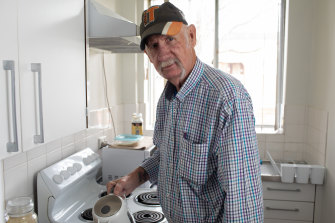
Bob Petersen in his new digs.Credit:Mark Newsham
What is the single best solution?
When we follow people such as Petersen and Kent through the system, research shows one pathway has a better ending than most. It’s called Housing First and it means offering social housing to the people most in need without the usual conditions, such as income and sobriety. Once a need is identified, the first priority is finding that person a stable place to live – addressing their other issues, such as addictions, can come next. Where it’s been rolled out, such as Scotland, Canada, parts of the US and Scandinavia, people have been more likely to turn their lives around.
Clarke says places such as Finland have stood out for enshrining the model into national policy. Finland spent 250 million euros ($418 million) building 3500 new homes, and hiring 300 extra support workers but long-term expects to save 15,000 euros ($25,000) a year for every person housed, as costs in emergency healthcare, social services and the justice system are cancelled out. Homelessness is down 35 per cent since 2008, and long-term homelessness has more than halved. In the capital Helsinki, you don’t see rough sleeping any more – just one shelter remains open during winter.
Australia’s COVID hotel response has shown Housing First can work on a big scale here too, Parsell says, even if most housing offered so far has only been temporary. “NGOs told us that for the first time that they could remember they were able to get every person they saw a bed, and people who wouldn’t normally take offers, the ones wary of being shuttled through shelters and back out again, they were saying yes too.
“There’s been successful pilots in most capital cities in Australia. The hard bit is scaling it up – and getting those support services in place to help them rebuild their lives.â€
NSW and Victoria are having a real crack, committing tens of millions of dollars to moving people from hotels into long-term housing over the next two years, including wrap-around support. Short-term, they hope to get around the social housing shortfall by head-leasing: taking up the lease of private properties and paying the gap between market rent and what someone in need can afford.
“I’ve heard first-hand so many incredible stories of people who’ve turned their lives around in recent months,” says NSW Minister for Families, Communities and Disability Services Gareth Ward. Some will go on to reconnect with family, improve their health, study or find a job and be part of the economic recovery, he says.
Close to 600 people have already been placed into secure housing in NSW in the past six months – the number usually housed in two years. In Victoria, 1100 private rentals will be head-leased. But both state schemes last only two years. Long-term, NSW and Victoria have flagged more spending on social housing in their upcoming budgets, which frontline workers say they hope will be spent on new builds not just repairing ageing stock.
Like most of the people put up in hotels during the pandemic tracked by the Monitor, Kent was at once grateful and wary. But since moving into his long-term rental in Melbourne, he’s managed to kick drugs for the first time in decades. “Things taste better. I have my own pillow. I can actually sleep.â€
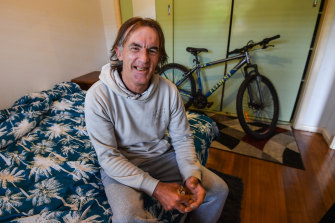
Glenn Kent was helped into secure housing by Launch and Victorian government funding during the pandemic.Credit:JOE ARMAO
What’s the business case for social housing?
University of Melbourne economist Lisa Cameron lives in what was once a public housing unit, built during the Second World War, and says the business case for building more social housing today is as strong as it was in 1945. Again the economy needs big spending stimulus. And, with the bond rate now low (around 0.8 per cent), she says the federal government can borrow money for virtually no interest. As former prime minister Paul Keating told ABC Radio in September: “We could be building public housing ’til the cows come home.”
When the Economic Society of Australia polled 49 top economists on their ideal wish list for COVID recovery spending, social housing topped the list (just ahead of permanently boosting welfare payments). But it was absent on budget night. Instead, Treasury earmarked $1 billion worth of cheap loans for community providers looking to build affordable housing themselves.
While the Coalition has suggested more social housing may be in order, it says the extra cash should come from the states, although the homes are funded by both levels of government.
But Clarke says the initial post-World-War-II heyday of public housing was driven by the Commonwealth as were resurgences during the 1970s and, briefly, during the financial crisis stimulus splash by the Rudd government.
“It’s always come from the federal government, they have the deepest pockets for revenue. The states can’t do it alone.â€
Grattan Institute economist Brendan Coates says a national social housing build would offer more construction jobs than the infrastructure projects that did make it into the budget, many of which are big spends on roads and rail.
Social housing also offers more bang for our government buck than the tax breaks handed out, he says. “They’re good policy, but they’re not enough.”
How much social housing do we need?
Pawson was among researchers who calculated that Australia would need to build 15,000 new social units a year just to keep pace with population growth. That was before the pandemic stamped down migration. But while the forecast will have changed to some degree, he says more people are about to find themselves in poverty for the first time as eviction bans and income support during COVID wind down. The sector is already seeing signs of a coming stampede in the cheaper end of the rental market, Warner says.
Some experts would like to see Australia ramp up its social housing stock considerably, until it’s more in line with countries such as the UK at 10 to 15 per cent. But Coates says even growing the stock back up to 5 per cent would mean building about 100,000 new homes, which he estimates would set the government back about $30 billion.
“That’s as large a number as I can imagine a government going in one hit, even one committed to doing something big,†he says. “We’d recommend building 30,000 homes for about $10 billion to start.â€
While there are clear savings to offering housing to the most vulnerable, he says value for money fades once you start putting those further up the ladder into social housing. “I don’t think everyone on a low income needs social housing. Early intervention and raising Renter’s Allowance is a more effective way of targeting those people who can stay in the private market with a bit of help.â€
Some countries which have rolled out Housing First widely, such as Scotland, already had high levels of social housing. “They have billions of dollars of these assets,†Coates says. “For us to build or buy up that much stock would be hugely expensive. Singapore has great housing as well but the government owns 80 per cent of it.”
There are cautionary tales too, most recently in New Zealand where Prime Minister Jacinda Arden’s ambitious plan to build 100,000 affordable houses in 10 years was abandoned after just two years, miles behind its targets. Many of the homes had been built in areas no one wanted to live. Attempts to scale up Housing First across the US under the Bush administration also failed to plan the builds appropriately and many were not directed at the people most in need, and so did not make up enough savings by offsetting their costs.
Pawson agrees that what works in one country can’t simply be copied across to another. “What Finland did is not a magic bullet. You need to adapt it.”
Could private investment save the day?
As it has for most social problems, the private sector is already working to tackle homelessness, in its way. But, while clever plans to repurpose unused office space or car parks as accommodation are welcome, experts say the market alone cannot solve homelessness.
Australia could follow the US approach and offer tax incentives for businesses investing in affordable housing, which offers tenancies around 20 per cent below market rent. Warner says about $10 billion in tax credits is already given out each year via negative gearing to help Australians buy a second or third home so “why isn’t there anything for people without one?â€
But Coates offers a warning from our not-too-distant history. When the Rudd government invested in housing to stimulate the economy after the global financial crisis, it launched two main programs. The first spent $5.2 billion to build 20,000 social housing units and refurbish 80,000 others in two years and, after coming in on time and under budget, was heralded a success. The other, which offered tax incentives to private enterprise to build affordable housing, cost $3.1 billion but was abandoned as a failure in 2014.
The problem? Coates says the government handed out too much money to the market for what it could have done itself at half the cost.
Affordable housing is cheaper than social housing. In the case of the Rudd-era scheme, that should have cost the government just $4000 a year per household but instead, a Grattan analysis found, it was paying $11,000, almost as much as public housing. It was, effectively, a $7000 windfall for the private sector.
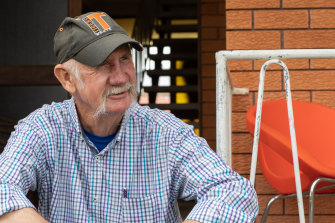
“I can breathe again.” Bob Petersen is getting back on his feet after years sleeping rough on trains and in parks.Credit:Mark Newsham
How can cities help solve the problem?
While solutions often struggle to find purchase at a national level, cities around the world are making a real difference. In northern Italy, Trieste has radically reduced homelessness by reshaping mental health policy. And 11 cities across the US have already reached a standard called “functional zeroâ€, meaning when homelessness does happen it’s rare and it’s brief.
Adelaide and now, to some extent Sydney, are shooting for the same target and working to improve street counts and co-ordinate their data across support service. The idea is to know everyone on the street by name and circumstance, so resources can be targeted. Some centralised models overseas have been likened to contact tracing or the programs that once helped eradicate smallpox. At Launch, Warner hopes to turbocharge the approach in Victoria, under a “Melbourne Zero†plan he says will need community buy-in as well as government support and transparency.
“It’s about saying, ‘OK Melbourne, we’ve taken a big hit but as we rebuild and reclaim this city, let’s meet this moment too. Let’s get to zero, and [track how we’re doing] against other cities. Let’s use real-time data to respond to what we’re seeing on the street. Let’s know their names. Let’s stop walking by.â€
Sherryn Groch is the explainer reporter for The Age and The Sydney Morning Herald.
Most Viewed in National
Loading
